 Technology peripherals
Technology peripherals
 AI
AI
 From point to surface: generalizable manifold adversarial attacks, from individual adversarial to manifold adversarial attacks
From point to surface: generalizable manifold adversarial attacks, from individual adversarial to manifold adversarial attacks
From point to surface: generalizable manifold adversarial attacks, from individual adversarial to manifold adversarial attacks
Is the facial recognition system that claims to be 99% accurate really unbreakable? In fact, the face recognition system can be easily broken by making some changes in face photos that do not affect visual judgment. For example, the girl next door and the male celebrity can be judged as the same person. This is an adversarial attack. The goal of adversarial attacks is to find adversarial samples that are natural and can confuse the neural network. In essence, finding adversarial samples is to find the vulnerabilities of the neural network.
Recently, a research team from Dongfang University of Technology proposed a paradigm of generalized manifold adversarial attack (Generalized Manifold Adversarial Attack, GMAA),Promote the traditional "point" attack mode to the "surface" attack mode, which greatly improves the generalization ability of the adversarial attack model and develops a new idea for the work of adversarial attacks.
This research improves previous work from two aspects: target domain and adversarial domain. On the target domain, this study finds more powerful adversarial examples with high generalization by attacking the set of states of the target identity. For the adversarial domain, previous work was looking for discrete adversarial samples, that is, finding several "loopholes" (points) of the system, while this research is looking for continuous adversarial manifolds, that is, finding the fragile integral parts of the neural network. Piece "area" (face). In addition, this research introduces domain knowledge of expression editing and proposes a new paradigm based on expression state space instantiation. By continuously sampling the generated adversarial manifold, we can obtain highly generalizable adversarial samples with continuous expression changes. Compared with methods such as makeup, lighting, and adding perturbations,the expression state space is more universal and natural, and is not affected by Effects of gender and lighting. Research paper has been accepted for CVPR 2023.

Code link https://github.com/tokaka22/GMAA
Method introduction
In the target domain part, previous work They all design adversarial samples for a specific photo of target identity A. However, as shown in Figure 2, when the adversarial sample generated by this attack method is used to attack another photo of A, the attack effect will be significantly reduced. In the face of such attacks, regularly changing the photos in the facial recognition database is naturally an effective defense measure. However, the GMAA proposed in this study not only trains on a single sample of the target identity, but also looks for adversarial samples that can attack the set of target identity states.
Such highly generalized adversarial samples face updated people The face recognition library has better attack performance. These more powerful adversarial samples also correspond to the weaker areas of the neural network and are worthy of in-depth exploration. In the adversarial domain part, previous work has been to find one or several discrete adversarial samples, which is equivalent to finding one or several vulnerable neural networks in high-dimensional space. "Point", and this study believes that the neural network may be fragile on the entire "face", and the adversarial samples on this "face" should be "caught in one sweep". Therefore, this research is devoted to finding adversarial manifolds in high-dimensional space.
In summary, GMAA is a new attack paradigm that uses
adversarial manifolds to attack the state set of the target identity. The core idea of the article is shown in Figure 1.
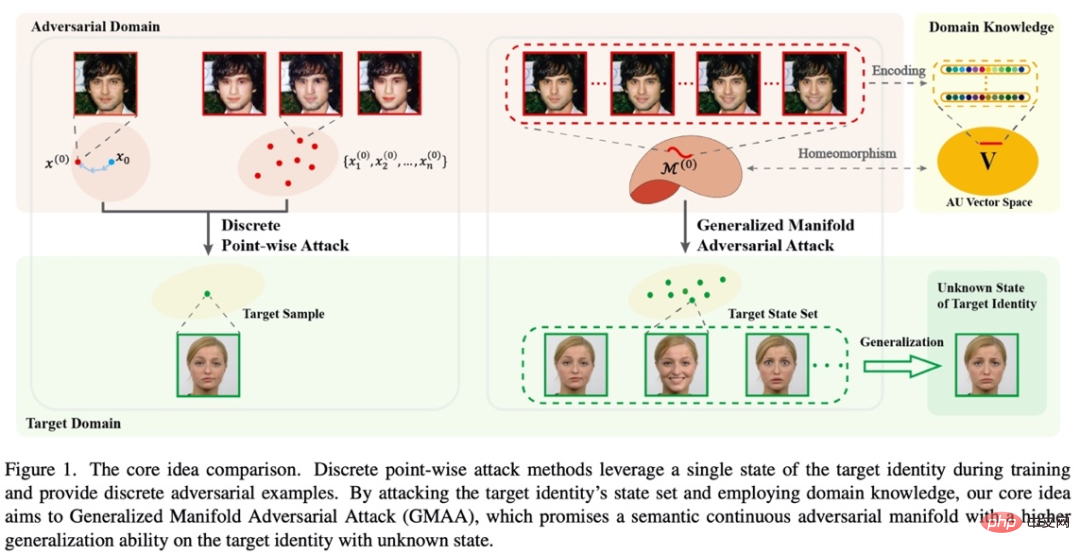
Specifically, this research introduces the domain knowledge of expression editing, Facial Action Coding System (FACS), and uses the expression state space to instantiate the proposed new attack paradigm. FACS is a facial expression coding system that divides the face into different muscle units. Each element in the AU vector corresponds to a muscle unit. The size of the vector element value represents the degree of muscle activity of the corresponding unit, thereby encoding Expression status. For example, in the figure below, the first element AU1 in the AU vector represents the degree of lifting the inner eyebrow.
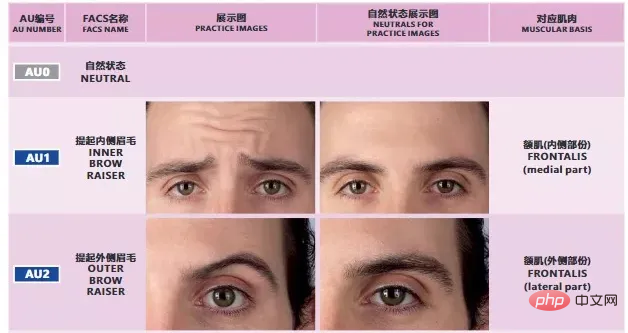
From "The Anatomy of Facial Expressions"
For the target domain, this research attacks target sets containing multiple expression states, thereby achieving better attack performance on unknown target photos; for the adversarial domain, this research establishes an adversarial manifold corresponding to the AU space. Adversarial samples can be sampled on the adversarial manifold by changing the AU value, and by continuously changing the AU value, adversarial samples with continuously changing expressions can be generated.
#It is worth noting that this research uses expression state space to instantiate the GMAA attack paradigm. This is because expression is the most common state in human facial activities, and the expression state space is relatively stable and will not be affected by race or gender (light can change skin color, and makeup can affect gender) . In fact, as long as other suitable state spaces can be found, this attack paradigm can be generalized and applied to other adversarial attack tasks in nature.
Model results
The animation below shows the visual results of the study. Each frame of the animation is an adversarial sample sampled on the adversarial manifold. By continuously sampling, a series of adversarial samples (left side) with continuously changing expressions can be obtained. The red value indicates the adversarial sample and target sample of the current frame. (Right) Similarity under Face facial recognition system.
In Table 1, the study lists the black box attack success rates of 4 face recognition models on two data sets. Among them, MAA is a shortened version of GMAA, and MAA is only In the adversarial domain, the point attack model is extended to the manifold attack, and in the target domain, a single target photo is still attacked. The state set of attack targets is a common experimental setting. The article adds this setting to three methods including MAA in Table 2 (the bold part in the table is the result of adding this setting, in Table 2 (A “G” is added to the name of the method to distinguish it), which proves that the expansion of the target domain can improve the generalization of adversarial samples.
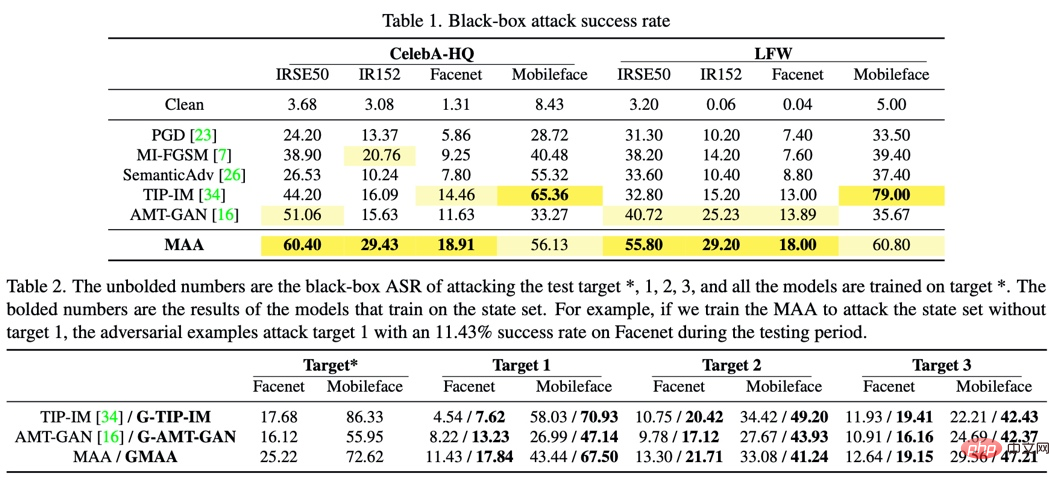
Figure 4 shows the results of attacking the APIs of two commercial facial recognition systems.

#The study also explored the impact of different expressions on attack performance, and the impact of the number of samples contained in the state set on attack generalization performance .
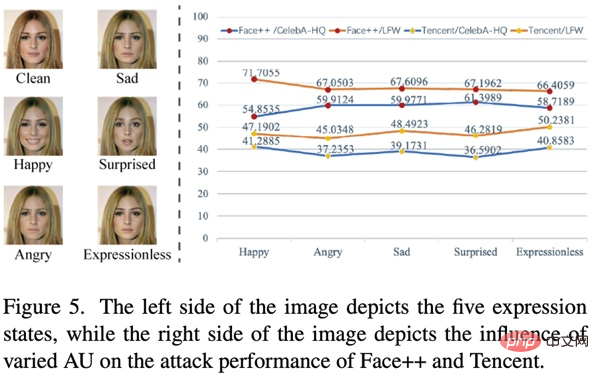

Figure 6 shows the comparison of visual results of different methods. MAA is better at fighting 20 adversarial samples were sampled on the manifold, and you can see that the visualization effect is more natural.

Of course, not all data sets have pictures of different statuses of an identity. How to expand the target domain in this case? This research also provides a feasible solution, which is to use AU vectors and expression editing models to generate target state sets. The article also presents the results of attacking the synthesized target state set, and it can be found that the generalization performance has also been improved.
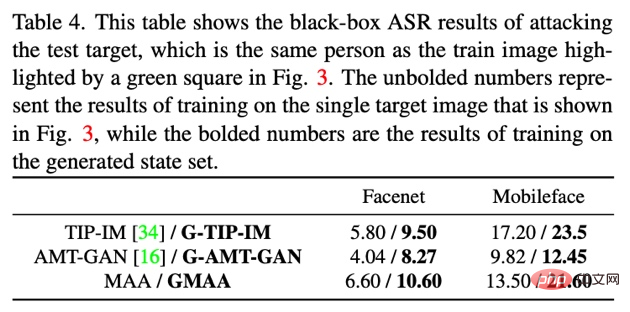
Principles and Methods
The backbone of the model includes a WGAN-GP-based generation module, expression supervision module, and transferability enhancement Module, generalized attack module. Among them, the generalized attack module implements the function of attacking target state sets, and the transferability enhancement module comes from previous work. For fair comparison, this module is added to all baselines. The expression supervision module is composed of 4 well-trained expression editors, and realizes the expression transformation of adversarial samples through global structure supervision and local detail supervision.
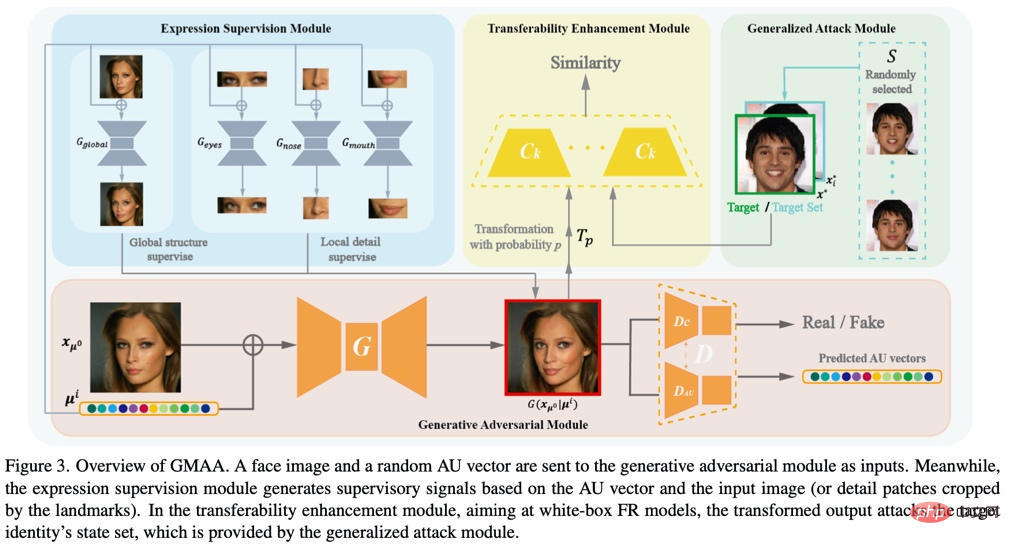
For the expression supervision module, the corresponding ablation experiments are given in the supporting materials of the paper, which verify that local detail supervision can reduce the artifacts of the generated images. It effectively improves the visual quality of adversarial samples and improves the expression synthesis accuracy of adversarial samples.
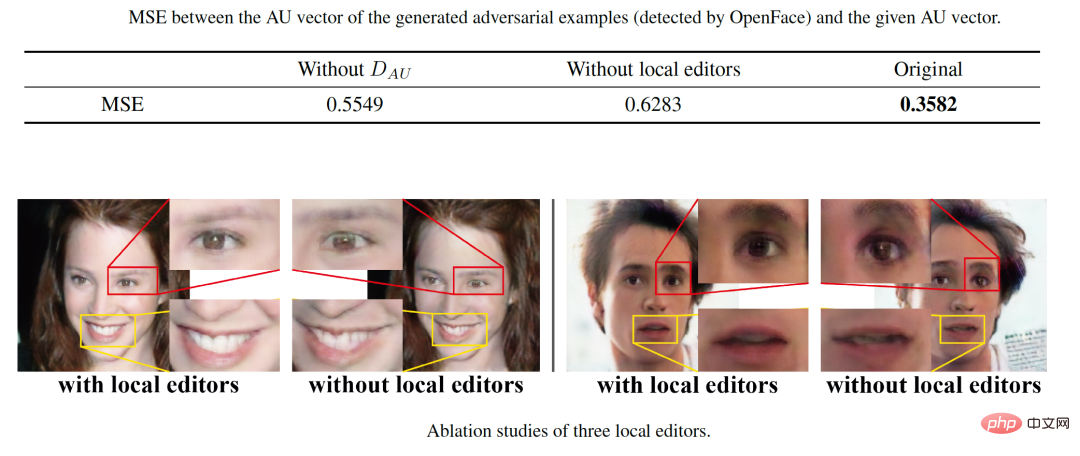
In addition, the paper defines the concepts of continuous adversarial manifolds and semantic continuous adversarial manifolds , and proved in detail that the adversarial manifold generated by is homeomorphic to the AU vector space.


Summary As mentioned above, this research proposes a new attack paradigm called GMAA, while expanding the target domain and countermeasure domain, improving the performance of the attack. For the target domain, GMAA improves the generalization ability to the target identity by attacking a collection of states instead of a single image. Additionally, GMAA extends the adversarial domain from discrete points to semantically continuous adversarial manifolds ("point-to-face"). This study instantiates the GMAA attack paradigm by introducing domain knowledge of expression editing. Extensive comparative experiments prove that GMAA has better attack performance and more natural visual quality than other competing models.
The above is the detailed content of From point to surface: generalizable manifold adversarial attacks, from individual adversarial to manifold adversarial attacks. For more information, please follow other related articles on the PHP Chinese website!

Hot AI Tools

Undresser.AI Undress
AI-powered app for creating realistic nude photos

AI Clothes Remover
Online AI tool for removing clothes from photos.

Undress AI Tool
Undress images for free

Clothoff.io
AI clothes remover

Video Face Swap
Swap faces in any video effortlessly with our completely free AI face swap tool!

Hot Article

Hot Tools

Notepad++7.3.1
Easy-to-use and free code editor

SublimeText3 Chinese version
Chinese version, very easy to use

Zend Studio 13.0.1
Powerful PHP integrated development environment

Dreamweaver CS6
Visual web development tools

SublimeText3 Mac version
God-level code editing software (SublimeText3)

Hot Topics
 1664
1664
 14
14
 1423
1423
 52
52
 1317
1317
 25
25
 1268
1268
 29
29
 1246
1246
 24
24
 CUDA's universal matrix multiplication: from entry to proficiency!
Mar 25, 2024 pm 12:30 PM
CUDA's universal matrix multiplication: from entry to proficiency!
Mar 25, 2024 pm 12:30 PM
General Matrix Multiplication (GEMM) is a vital part of many applications and algorithms, and is also one of the important indicators for evaluating computer hardware performance. In-depth research and optimization of the implementation of GEMM can help us better understand high-performance computing and the relationship between software and hardware systems. In computer science, effective optimization of GEMM can increase computing speed and save resources, which is crucial to improving the overall performance of a computer system. An in-depth understanding of the working principle and optimization method of GEMM will help us better utilize the potential of modern computing hardware and provide more efficient solutions for various complex computing tasks. By optimizing the performance of GEMM
 Huawei's Qiankun ADS3.0 intelligent driving system will be launched in August and will be launched on Xiangjie S9 for the first time
Jul 30, 2024 pm 02:17 PM
Huawei's Qiankun ADS3.0 intelligent driving system will be launched in August and will be launched on Xiangjie S9 for the first time
Jul 30, 2024 pm 02:17 PM
On July 29, at the roll-off ceremony of AITO Wenjie's 400,000th new car, Yu Chengdong, Huawei's Managing Director, Chairman of Terminal BG, and Chairman of Smart Car Solutions BU, attended and delivered a speech and announced that Wenjie series models will be launched this year In August, Huawei Qiankun ADS 3.0 version was launched, and it is planned to successively push upgrades from August to September. The Xiangjie S9, which will be released on August 6, will debut Huawei’s ADS3.0 intelligent driving system. With the assistance of lidar, Huawei Qiankun ADS3.0 version will greatly improve its intelligent driving capabilities, have end-to-end integrated capabilities, and adopt a new end-to-end architecture of GOD (general obstacle identification)/PDP (predictive decision-making and control) , providing the NCA function of smart driving from parking space to parking space, and upgrading CAS3.0
 Always new! Huawei Mate60 series upgrades to HarmonyOS 4.2: AI cloud enhancement, Xiaoyi Dialect is so easy to use
Jun 02, 2024 pm 02:58 PM
Always new! Huawei Mate60 series upgrades to HarmonyOS 4.2: AI cloud enhancement, Xiaoyi Dialect is so easy to use
Jun 02, 2024 pm 02:58 PM
On April 11, Huawei officially announced the HarmonyOS 4.2 100-machine upgrade plan for the first time. This time, more than 180 devices will participate in the upgrade, covering mobile phones, tablets, watches, headphones, smart screens and other devices. In the past month, with the steady progress of the HarmonyOS4.2 100-machine upgrade plan, many popular models including Huawei Pocket2, Huawei MateX5 series, nova12 series, Huawei Pura series, etc. have also started to upgrade and adapt, which means that there will be More Huawei model users can enjoy the common and often new experience brought by HarmonyOS. Judging from user feedback, the experience of Huawei Mate60 series models has improved in all aspects after upgrading HarmonyOS4.2. Especially Huawei M
 Which version of Apple 16 system is the best?
Mar 08, 2024 pm 05:16 PM
Which version of Apple 16 system is the best?
Mar 08, 2024 pm 05:16 PM
The best version of the Apple 16 system is iOS16.1.4. The best version of the iOS16 system may vary from person to person. The additions and improvements in daily use experience have also been praised by many users. Which version of the Apple 16 system is the best? Answer: iOS16.1.4 The best version of the iOS 16 system may vary from person to person. According to public information, iOS16, launched in 2022, is considered a very stable and performant version, and users are quite satisfied with its overall experience. In addition, the addition of new features and improvements in daily use experience in iOS16 have also been well received by many users. Especially in terms of updated battery life, signal performance and heating control, user feedback has been relatively positive. However, considering iPhone14
 What are the computer operating systems?
Jan 12, 2024 pm 03:12 PM
What are the computer operating systems?
Jan 12, 2024 pm 03:12 PM
A computer operating system is a system used to manage computer hardware and software programs. It is also an operating system program developed based on all software systems. Different operating systems have different users. So what are the computer systems? Below, the editor will share with you what computer operating systems are. The so-called operating system is to manage computer hardware and software programs. All software is developed based on operating system programs. In fact, there are many types of operating systems, including those for industrial use, commercial use, and personal use, covering a wide range of applications. Below, the editor will explain to you what computer operating systems are. What computer operating systems are Windows systems? The Windows system is an operating system developed by Microsoft Corporation of the United States. than the most
 Differences and similarities of cmd commands in Linux and Windows systems
Mar 15, 2024 am 08:12 AM
Differences and similarities of cmd commands in Linux and Windows systems
Mar 15, 2024 am 08:12 AM
Linux and Windows are two common operating systems, representing the open source Linux system and the commercial Windows system respectively. In both operating systems, there is a command line interface for users to interact with the operating system. In Linux systems, users use the Shell command line, while in Windows systems, users use the cmd command line. The Shell command line in Linux system is a very powerful tool that can complete almost all system management tasks.
 Detailed explanation of how to modify system date in Oracle database
Mar 09, 2024 am 10:21 AM
Detailed explanation of how to modify system date in Oracle database
Mar 09, 2024 am 10:21 AM
Detailed explanation of the method of modifying the system date in the Oracle database. In the Oracle database, the method of modifying the system date mainly involves modifying the NLS_DATE_FORMAT parameter and using the SYSDATE function. This article will introduce these two methods and their specific code examples in detail to help readers better understand and master the operation of modifying the system date in the Oracle database. 1. Modify NLS_DATE_FORMAT parameter method NLS_DATE_FORMAT is Oracle data
 How to enter DingTalk face recognition
Mar 05, 2024 am 08:46 AM
How to enter DingTalk face recognition
Mar 05, 2024 am 08:46 AM
As an intelligent service software, DingTalk not only plays an important role in learning and work, but is also committed to improving user efficiency and solving problems through its powerful functions. With the continuous advancement of technology, facial recognition technology has gradually penetrated into our daily life and work. So how to use the DingTalk app for facial recognition entry? Below, the editor will bring you a detailed introduction. Users who want to know more about it can follow the pictures and text of this article! How to record faces on DingTalk? After opening the DingTalk software on your mobile phone, click "Workbench" at the bottom, then find "Attendance and Clock" and click to open. 2. Then click "Settings" on the lower right side of the attendance page to enter, and then click "My Settings" on the settings page to switch.



